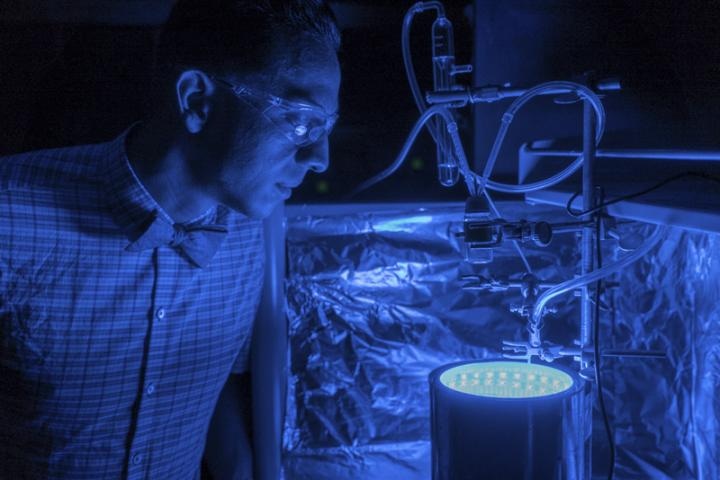Apr 26 2017
 (Credit: University of Central Florida)
(Credit: University of Central Florida)
University of Central Florida chemistry professor has recently discovered a method to trigger the process of photosynthesis in a synthetic material, converting greenhouse gases into clean air and generating energy simultaneously.
The process is highly promising for creating a technology that could considerably decrease greenhouse gases linked to climate change, while also developing a clean way to yield energy.
This work is a breakthrough. Tailoring materials that will absorb a specific color of light is very difficult from the scientific point of view, but from the societal point of view we are contributing to the development of a technology that can help reduce greenhouse gases.
Fernando Uribe-Romo, Assistant Professor, University of Central Florida
His research findings are published in the Journal of Materials Chemistry A.
Uribe-Romo and his team of students developed a method to activate a chemical reaction in a synthetic material called metal–organic frameworks (MOF) that breaks down carbon dioxide (CO2) into harmless organic materials. It is a sort of artificial photosynthesis process akin to the way plants convert sunlight and CO2 into food. But instead of producing food, Uribe-Romo’s technique produces solar fuel.
Scientists worldwide have been pursuing this kind of breakthrough for years. The challenge is finding a way for visible light to activate the chemical transformation. UV rays have sufficient energy to permit the reaction in basic materials such as titanium dioxide, but UVs constitute just roughly 4% of the light Earth receives from the sun. The visible range – the violet to red wavelengths – signify the majority of the sun’s rays, but there are some materials that pick up these light colors to produce the chemical reaction that converts CO2 into fuel.
Researchers have attempted it with various types of materials, but the materials that can absorb visible light are mostly rare and expensive such as platinum, iridium, and rhenium, which make the process unaffordable.
Uribe-Romo used titanium, a common harmless metal, and incorporated organic molecules that serve as light-harvesting antennae to tell if that configuration would function. The light harvesting antenna molecules, called N-alkyl-2-aminoterephthalates, can be engineered to absorb particular colors of light when added in the MOF. In this case, he synchronized it for the color blue.
His team put together a blue LED photoreactor to try out the hypothesis. Measured quantities of CO2 were gradually added into the photoreactor — a glowing blue cylinder that resembles a tanning bed — to observe if the reaction would happen. The glowing blue light appeared from strips of LED lights within the cylinder’s chamber and mimicked the sun’s blue wavelength.
It functioned and the chemical reaction transformed the CO2 into two condensed forms of carbon, formamides, and formate (two kinds of solar fuel) and in the process cleaning the air.
“The goal is to continue to fine-tune the approach so we can create greater amounts of reduced carbon so it is more efficient,” Uribe-Romo said.
He wants to test if the other wavelengths of visible light might also activate the reaction with changes to the synthetic material. If it is successful, the process could be an important way to help decrease greenhouse gases.
The idea would be to set up stations that capture large amounts of CO2, like next to a power plant. The gas would be sucked into the station, go through the process and recycle the greenhouse gases while producing energy that would be put back into the power plant.
Fernando Uribe-Romo, Assistant Professor, University of Central Florida
Maybe in the future, homeowners could buy rooftop shingles made of the material, which would not only clean the air in their neighborhood but also generate energy that could be used to power their homes.
That would take new technology and infrastructure to happen,” Uribe-Romo said. “But it may be possible.
Fernando Uribe-Romo, Assistant Professor, University of Central Florida
Other members of the team who assisted with the paper include UCF graduate student Matt Logan, who is pursuing a Ph.D. in chemistry, and undergraduate student Jeremy Adamson, who is majoring in biomedical sciences. With the assistance of Kenneth Hanson and his research group at Florida State University the results of the experiments were interpreted.